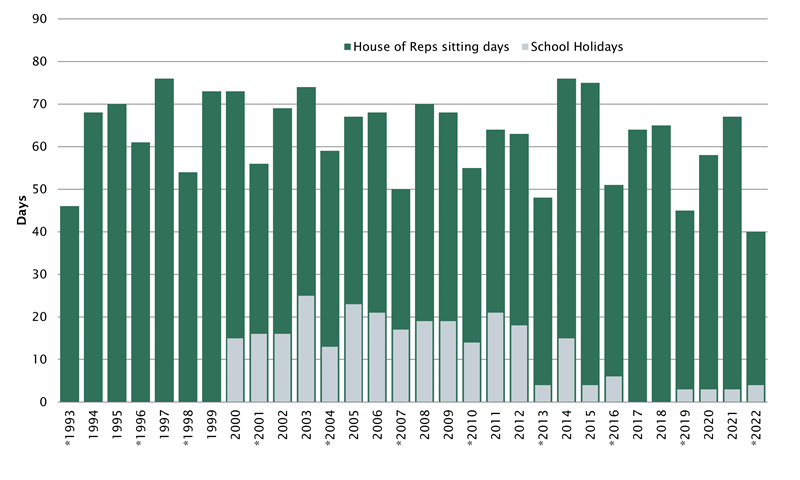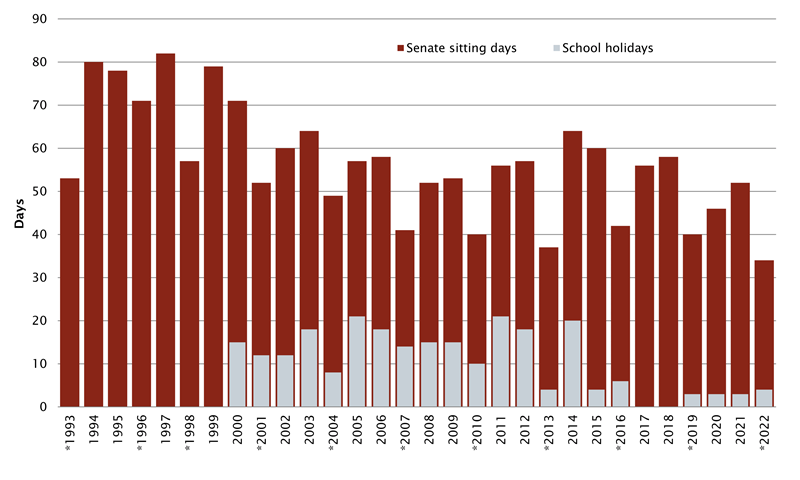Posted 29/11/2022 by Stephanie Gill
While children—young and old—in the countdown to Christmas are probably more focused on chocolate advent calendars, parliamentarians need to settle on a new sitting calendar.
Balancing the norms of a sitting calendar with Prime Minister Anthony Albanese’s promise not to sit during school holidays across all states and territories, requires careful programming. This Flagpost article discusses the various considerations that go into developing a sitting calendar including avoiding school holidays.
Rules and norms
The Senate (Odgers’ Australian Senate Practice) and the House of Representatives each set their own sitting calendars by resolution. House Practice and Procedure explains that the sitting calendar is implicitly a decision of the Government due to its majority support in the House.
Since 1994 there has been three sitting periods each year (Autumn, Winter and Spring) and standard days of sitting (Monday to Thursday). In addition, House Practice and Procedure explains that ‘[w]ithin a sitting period the House generally sits to a four weekly cycle of meetings, … for two weeks followed by two weeks without sittings’ (see also Votes and Proceedings 8/12/1983, p. 468).
Since these calendar norms have all been in effect (see Procedure Report 1993), there has been an average 62.43 days in the House and 56.63 days in the Senate (see Figures 1 and 2). This compares to the overall average 66.77 days in the House and 57.08 days in the Senate since Federation.
Figure 1 House of Representatives sitting days (including clashes with school holidays from 2000)

Figure 2 Senate sitting days (including clashes with school holidays from 2000)

Note: Asterisk indicates an election year. Sitting days excludes Senate Estimates.
Sources: Days of meeting, Sitting patterns, parliamentary events calendar
Navigating school holidays
Old concept …
For more than 20 years, the sitting calendar template has included a column noting when school holidays are (see Parliamentary Sittings for example). Between 2000 to 2011, the sitting calendar clashed with school holidays an average 18.25 days in the House and 14.92 days in the Senate. Since 2012 clashes have become far less frequent, with 5.45 days in the House and 5.91 days in the Senate (see Figures 1 and 2).
Since 2011 parliamentarians have sporadically advocated for the sitting calendar to not interfere with school holidays and being family friendly. This has included Christopher Pyne (then Leader of the House), Rachel Siewert and Larissa Waters, with the latter also saying ‘we've had a very good and positive tradition in this place of not scheduling sitting weeks in school holidays’. Additionally, in her evidence to the 2022 Joint Select Committee into parliamentary standards, legal academic Professor Rosalind Dixon argued there should be ‘a guaranteed norm that the parliament, absent an emergency, will not sit in school holidays of any state or territory’. Professor Dixon further indicated her view that guaranteeing this norm would encourage more women to run for politics.
… renewed commitment
In 2011, Anthony Albanese (then Leader of the House) noted that in developing the sitting calendar he ‘consciously’ took into account the parliament getting younger and there being young parents. After his election to Prime Minister in 2022, he promised to:
… run a family-friendly Parliament. There are school holidays in July that have been pointed out as well. But we will resume Parliament in a very orderly way.
This promise followed the Australian Human Rights Commission’s Set the Standard report into Commonwealth Parliamentary workplaces, which recommended the sitting calendar be reviewed. The report also noted that internationally parliamentary calendars have been aligned with school holidays.
When the House adopted the sitting calendar for the remainder of the 2022 year, the Government had achieved its goal of avoiding school holidays, despite acknowledging this as a ‘complex thing to do’.
The passing of Queen Elizabeth II on 8 September 2022, and the ensuing suspension of Parliament, interrupted the scheduled 12–15 September sittings. To make up for this missed sitting week, a revised sitting calendar was agreed to on 23 September, which clashed with nation-wide September school holidays.